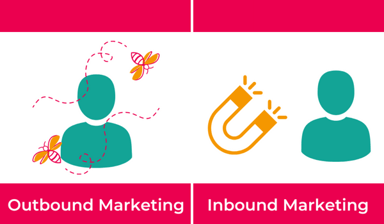TL;DR: Inbound marketing is not a trend, but a person-driven, tactical strategy for converting mere customers into brand evangelists.
As a business owner, how do you know where to spend your marketing dollars? There are 41 different types of marketing, and your decision might still be tough if there were only 10 types. Now, though, one type of marketing is becoming increasingly essential to organizational growth: inbound marketing.
The inbound concept isn’t new, and you may know some things about it. However, it can still be a confusing topic, particularly for those accustomed to more traditional marketing strategies, such as outbound marketing.
Here are some details to help you understand just how inbound marketing can work for your business.
What Is Inbound Marketing?
Inbound marketing is the process of creating valuable content and experiences for customers to build relationships with them and solve problems they already have.
In other words, organizations are able to meet their sales leads where they are in their purchase process and provide them with information and resources to convert those leads into customers.
Although marketing professionals may feel comfortable in traditional marketing strategies, they may not be as equipped with effective inbound strategies. The inbound marketing definition doesn’t clearly explain inbound vs. outbound marketing. So, what is the difference between inbound and outbound marketing?
Here are the significant differences between inbound and traditional marketing.
|
Traditional marketing is focused on the company, but inbound marketing is focused on the customer. |
Traditional marketing typically interrupts the customer’s activities, but inbound marketing provides the opportunity for the customers to choose to interact when they are ready. |
Traditional marketing is a one-sided conversation (toward the customer), but inbound marketing creates a two-way, interactive process. |
Traditional marketing may produce faster results, but inbound marketing uses a process to nurture people into becoming leads and then into customers. |
Inbound Marketing Is Cyclical
Whereas traditional marketing is a one-sided conversation, inbound marketing is a holistic process, engaging with and empowering potential customers through their journey from Stranger to Prospect to Customer and then to Promoter.
Effective marketing, sales, and service strategies accelerate the process of “Attract → Engage → Delight," which results in organizational growth. On the other hand, ineffective strategies cause friction throughout the process, stunting growth or even causing losses.
What Inbound Marketing Isn’t
First, let's take a look at some common misconceptions about inbound.
Inbound marketing isn’t a trend.
When people ask what is inbound marketing, they usually follow it up with, “Is it a trend?”
No, it isn't a trend. While it may seem new, inbound is just a modern take on human marketing methodologies. The inbound marketing methodology has revolutionized the way we look at how prospects search for information and make buying decisions. Effective inbound marketing strategies in website development, SEO, blogging, email, landing pages, forms, and social media are used to expedite the prospect’s journey.
Inbound marketing isn’t about selling.
No, it really isn't about selling. Instead, it is a paradigm shift that moves the spotlight from “the sale” to people. Inbound marketers are actually problem-solvers. As an inbound marketer, you answer questions and provide solutions, and attract your ideal customers.
Inbound marketing isn’t about interrupting people.
No, it isn't about interrupting people. Inbound marketing strategies and tactics should be like a magnet, not a bumble bee.

Consumers have far too many intrusive and obnoxious ads buzzing around their faces. The more efficient marketing strategy is to attract and engage consumers by giving them what they are looking for.
Now that we know what inbound isn’t about, what is inbound marketing?
What Inbound Marketing Is Really About
Inbound marketing centers around three core principles:
1. Inbound marketing is content centered.
Knowing where and how your ideal customers shop is key. Do they spend time on social media like Twitter or Facebook? Do they search LinkedIn? Do they enjoy educating themselves on topics via blogs or do they prefer video? Maybe they prefer to download detailed e-books to read at a later time.
Inbound marketing is a content-centered methodology. Its beauty is that it allows you to create multiple entry points into your business from a variety of sources. Content in external channels directs prospects to your website, whether that’s pillar or product pages, blog articles, how-to guides, or downloadable e-books.
2. Inbound marketing is about humans.
Inbound marketing strategies require you to learn about your prospects rather than prioritize the close. Asking them questions, listening and understanding what they say, and then empathizing with their pain are techniques to build relationships with them.
When you also humanize your brand and personalize your visitors’ experience with you, you quickly become the resource for informed buying decisions!
3. Inbound marketing is about trust.
Building relationships with prospective clients allows you to form a trusting bond with them. You proactively show you care by answering their questions, providing feedback, and educating them.
Once you prove you have their best interests at heart, they will actively choose you over your competitors. And by continuing to delight your customers past the purchase decision, your inbound sales strategy will lead to repeat business and strong referrals.
Getting Started with Your Inbound Marketing Strategy
Inbound marketing is current, it’s real, and it’s evolving. If you haven’t yet decided to invest in an inbound marketing strategy for your business, here are two marketing statistics that might tip the scale.
- A majority (44%) say they typically consume three to five pieces of content before engaging with a vendor, according to DemandGen.
- Companies publishing 16+ blog posts per month have nearly 3.5 more traffic than companies publishing four or fewer posts.
Are you ready to learn more about how inbound marketing works to grow your business?
Download The Beginner's Guide to Inbound Marketing for secrets, how-to instructions, and best practices.
 Cathy Roth
Cathy Roth The focus
The focus When it happens
When it happens How it happens
How it happens Speed of results
Speed of results